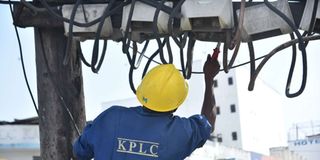November electricity prices drop 5pc on cheaper fuel

A Kenya Power employee carries out repairs on Haile Selassie Road, Mombasa. The fuel cost charge is the single-biggest variable cost in consumer billing that is adjusted monthly and is collected by Kenya Power on behalf of the expensive thermal power generators.
The Energy and Petroleum Regulatory Authority (Epra) has lowered the monthly unit cost of electricity generated from thermal sources by five per cent for November due to lower fuel prices, handing some relief to consumers.
The regulator has cut the fuel cost charge (FCC) to Sh6.36 per kilowatt-hour (kWh) down from Sh7.09 per unit. The FCC is the single-biggest variable cost in consumer billing that is adjusted monthly and is collected by Kenya Power on behalf of the expensive thermal power generators.
Epra has also cut the foreign exchange rate fluctuation component to Sh1.41 per unit down from Sh1.48.
The overall effect of the cuts has resulted in a five per cent reduction in the unit cost of electricity, with lifeline consumers who have been paying Sh20 a unit of electricity now set to pay Sh19.
This bucks a trend of rises in power prices for two consecutive months to October.
A raise in November would have pushed the cost of the commodity to the highest level in nearly a decade.
Epra in its review for the October 15 to November 14 schedule reduced the prices of petrol and kerosene by Sh1 and diesel by Sh2 per litre. Petrol currently retails at Sh178.3, Sh163 for diesel and Sh146.94 for kerosene per litre in Nairobi.
The Epra in September made a U-turn and increased electricity prices by 15.7 per cent, reversing the January cuts by former President Uhuru Kenyatta's administration, in what has handed consumers a twin blow in the wake of higher fuel prices.
The lower November prices are a major relief for consumers at a time the cost of living has hit the highest level in 64 months.
High food, transport, and household commodity prices have elevated inflation further to a 5.4-year high of 9.6 per cent, highlighting the pain households continue to endure in the face of a worsening cost of living.
This is the fifth month in a row for the country’s inflation to stay above the Central Bank of Kenya’s 7.5 per cent ceiling, underlining the hardships Kenyan households remain in even as the situation is expected to get worse following this year’s poor rains and poor agricultural performance.
The last time Kenya’s inflation crossed the current figure was May 2017, when it hit 11.7 per cent. High power costs this year have decelerated the growth of the energy sector, according to official data.
Data from the Kenya National Bureau of Statistics show high energy costs decelerated to five per cent between April-June compared to 7.2 per cent in the same quarter last year.
While only 7.69 per cent of the energy is generated from thermal sources whose costs contribute to 13 per cent of Kenya Power’s entire purchase costs.





